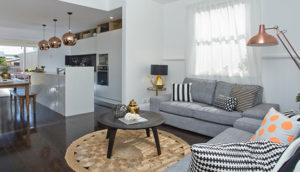Do you struggle in choosing the right lights for your property? Rapid Reno Expert Naomi Findlay sheds light on this question.
Having been involved in more than a hundred renovation projects, I’ve found that lighting can be one of those struggles that many renovators and homeowners don’t see coming. Many don’t know that there are specific light functions and that certain types of light are recommended for specific areas in a property.

Whether you’ve experienced these challenges in the past, or are facing questions about lighting right now, this guide will be sure to help you choose the correct lighting for your home or investment property.
1. FUNCTION: What Purpose Will The Light Serve?
First, you should think about how people make use of light when it comes to their daily activities. This is what we call ‘lighting function’, and here’s five examples:
Ambient Lights. The natural light that comes through your windows and doors or the lighting substitute for natural light.
Examples: chandeliers, track lighting, and recessed cans
Task Lights. Helps you accomplish a specific activity. Often, task lighting helps provide additional light so for visual clarity.
Examples: reading lights, desk lamps, under cabinet lighting, floor lamp, and magnifying task lights
Accent Lights. Helps you focus on an area or a subject. The common places to find accent lighting are in galleries and museums.
Examples: track lighting, sconces, floodlights, recessed lights, and torchiere lights
Kinetic Lights. ‘Kinetic’ means movement, so this pertains to lighting that is ‘moving’.
Examples: a burning candle or the light in the fireplace
Decorative Lights. Meant to express your personal style and preference, decorative lighting is used to help decorate a space or a room.
Example: dimmable lights
2. SPACE: Where Will You Use The Light?
Second, think about which part of your property can benefit from the functions of light mentioned above. Here are some of my recommendations:
Living Room. Ambient light for general room illumination and accent light to highlight a piece of decor or furniture.
Kitchen. Overhead ambient light for general room illumination and task lights on kitchen work spaces like the counter and the sink.
Bedroom. Task lights situated on the nightstand and ambient light that points towards the dressing area.
Bathroom. Task lights on either side of the mirror and an overhead ambient light for general illumination.
Dining room. Overhead ambient light and some decorative lights directly above the dining table.
3. INTENSITY: How Bright Should The Light Be?
Third, I’d suggest considering the strength of light that’s recommended for each room in your property. Here’s a useful guide:
Soft or Warm White. Providing a warm and cosy feeling in a room, soft and warm whites are ideal for living rooms and bedrooms.
Bright or White. Ideal when you want to give a room an energetic feel. Bright or white lights are recommended for use in bathrooms, kitchens, and garages.
Daylight. Suitable for reading, for detail-oriented projects, and even for applying makeup, daylight is best for use in the kitchens, basements, and bathrooms.
4. FIXTURES: What Lighting Style Should You Use?
Fourth, and this is often the one homeowners and renovators try to do first, you now need to choose lighting that is to the style and existing theme of the space (not just what looks good in the shop). Consider these tips:
Ceiling Mount Fixtures. Commonly standard in ambient lights, and ideal for use in hallways, foyers, stairways, and task areas.
Chandeliers. Recommended for use in bedrooms and dining rooms. They’re suitable when creating ambient light.
Pendant Light Fixtures. Used in ambient lighting, they’re ideal for work areas, dining room tables, and kitchen countertops.
Recessed Light Fixtures. Generally can be used anywhere in the house for accent, ambient, or task lights.
Table Lamp Fixtures. Perfect for accent lighting in the living room or task lighting in the study and in the bedroom.
Track Lighting. Similar to recessed lighting, track lighting can be used anywhere in the house. For example, they can be used to highlight an art decor or simply for general illumination.
Wall-mounted Fixtures. Can be used for accent, ambient, or task lights. The sconce is a common example.
IN SUMMARY
When you’re home styling or renovating for a profit, you always have to think about what your target market wants to see, feel, or even smell. In this case, lighting becomes an integral part of what prospective renters or buyers will experience when viewing your property. Give them a great experience by making excellent choices.
The Property Renovation Library | The Property Renovation Video Hub

